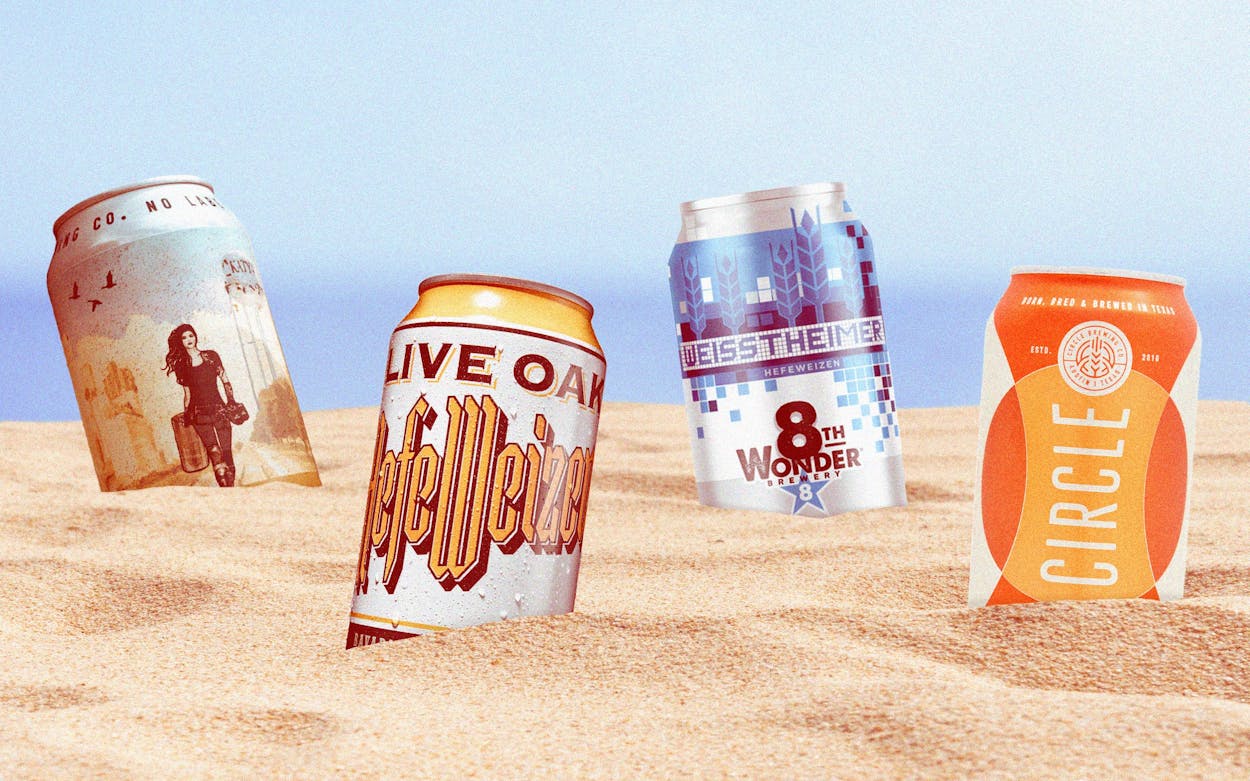My love for hefeweizens goes back to my earliest days of drinking “good beer.” In the early 2000s in Orlando, I drank Tucher Helles Hefe Weizen with my soon-to-be fiancée. Once married, we moved to New York and consumed half the Hofbräu Hefe Weizen in Brooklyn. A visit to Munich only solidified my devotion, after I sampled fresh versions from Augustiner-Bräu and Ayinger Bräustüberl. When we moved to Austin in 2008, I knew we had picked a great place to settle after my first sip of Live Oak HefeWeizen.
With record-breaking heat across Texas and anxieties over our delicate electrical grid, I find myself reaching for the light, easy-drinking style more frequently. Lagers get a lot of love, including Mexican-style lagers, which have recently had their day in the sun, but hefeweizens are more ideal. They’re found virtually all over the state, with many Texas breweries putting out delicious examples of the style.
Hefeweizen literally means “yeast wheat” in German. Hefeweizens are warm-fermented, unfiltered wheat beers. Because the beer is unfiltered, the yeast stays in suspension in the glass, giving the liquid a signature cloudy appearance. Traditionally—and under German law—hefeweizens are made with at least 50 percent malted wheat. The two dominant flavor characteristics are usually banana and clove, but vanilla and bubble gum are also often present. Hefeweizens are typically lower in alcohol and bitterness, making them extremely drinkable.
“Hefe is a great summer beer because the clove, vanilla, and bubble gum flavors meld well with everyone’s cheerful summer attitudes,” says Dusan Kwiatkowski, head brewer at Austin’s Live Oak Brewing Company. “Low bitterness allows for less palate fatigue when liquid intake and temperatures are above average.”
If you are saying to yourself, “Sounds like Blue Moon,” you’re not too far off. Blue Moon and similar beers, like Austin’s Celis White, are witbiers. These Belgian cousins of hefeweizens are also wheat beers, and while there are some similarities, the flavor profiles are very different. There are other styles of wheat beers as well, and they’ve been around awhile.
Hefeweizens, as we know them today, had their roots in the wheat beers of twelfth or thirteenth century Bohemia, which later made their way down to Bavaria. In 1520, the Degenberg family was given exclusive rights by the ruling dynasty of Bavaria, the Wittelsbach, to brew weissbier (“white beer”), which includes hefeweizens. The family had control of the wheat beer market until 1602, when no heirs were left. The dukes of Bavaria then took over control of weissbier until 1798, when they gave brewing permission to some monasteries and non-Wittelsbach breweries. Weissbier declined in popularity, though, and most breweries stopped making the style. In 1872, the Wittelsbach dukes sold off the rights for production to Georg Schneider I. The Schneider family kept plugging away at making weissbier, and its dedication was rewarded in the mid-1960s when the beer style became popular once again.
Weissbier came to America with German immigrants in the nineteenth century, but Prohibition basically killed the style off until the 1980s, when craft upstarts, like West Coast brewers Pyramid Brewing and Anchor Brewing, released their own versions and spawned new interest in hefeweizens. Today, tons of craft breweries include hefeweizens in their year-round beer quivers.
A proper pour of hefeweizen would be in a tall, vaselike glass with a slender middle that curves out before tapering at the rim. But don’t let that limit you. Jason Watkins, head brewer at Two Docs Brewing, in Lubbock, suggests mixing it “with orange juice and ice to make a hefe-mosa or just [enjoying it] on the rocks.”
Kwiatkowski prefers his hefeweizen with the rising sun. “Hefe is largely an a.m. beer for me, perfect with that breakfast hot dog fresh off the grill,” he says.
Texas has breweries all around the state producing fine examples of this Bavarian-style treat. Many of these beers are packaged and distributed to bars and restaurants, but the best way to enjoy them is fresh from the source.
Central
We might as well start with the finest and most famous, mentioned above—Live Oak Brewing’s HefeWeizen. Also in Austin, Circle Brewing’s Blur is a great one for pregaming before heading down the street for an Austin FC match. Further south, in San Antonio, head downtown for a Weisse Guys from Dos Sirenos Brewing or a hefeweizen on the heavy side called Cashmere from Künstler Brewing.
South
Headed to Corpus Christi to pay respects at the Selena Memorial Statue? Pick up a six-pack of Nueces Brewing’s Hefeweizen to knock back at the beach. Even the Rio Grande Valley is brewing up solid hefes. The patio at Brewsome in McAllen is a pleasant place to sip its Hefeweizen.
East
Back up the coast, in Houston, there are plenty of hefeweizens to go around, like Great Heights Brewing’s Hefeweizen. In downtown, take a break from the concrete jungle with a Weisstheimer in 8th Wonder Brewery’s beer garden. Houston’s German-style specialist, Klaus Brewing, of course has a stellar hefe on offer, named Edelweizen. Just outside Houston, Katy residents have been enjoying El Hefe from No Label Brewing for over a decade.
North
With the combined forces of two large cities, Dallas and Fort Worth, North Texas has loads of hefeweizens to sample. In Dallas, you can’t go wrong with either Great Hall Hefe from Pegasus City Brewery or Oak Cliff Brewing’s Hefeweizen. In Fort Worth, among a fortress of refurbished shipping containers, Fort Brewery is serving up the terrific Grey Eagle.
West
Farther west, hefeweizens are scarcer, but if you know where to look, the wheat will be yours. With Live Oak alum Jason Watkins as the head brewer, Lubbock’s Two Docs Brewing delivers the on-point Weller Weiss. In El Paso, DeadBeach Brewery’s Chi-Hua-Hefe is the best hefe you will find before crossing into New Mexico.
This story originally published online on July 19, 2022. An abbreviated version of it appeared in the October 2022 issue of Texas Monthly with the headline “A Bit of Adweiz.” Subscribe today.






